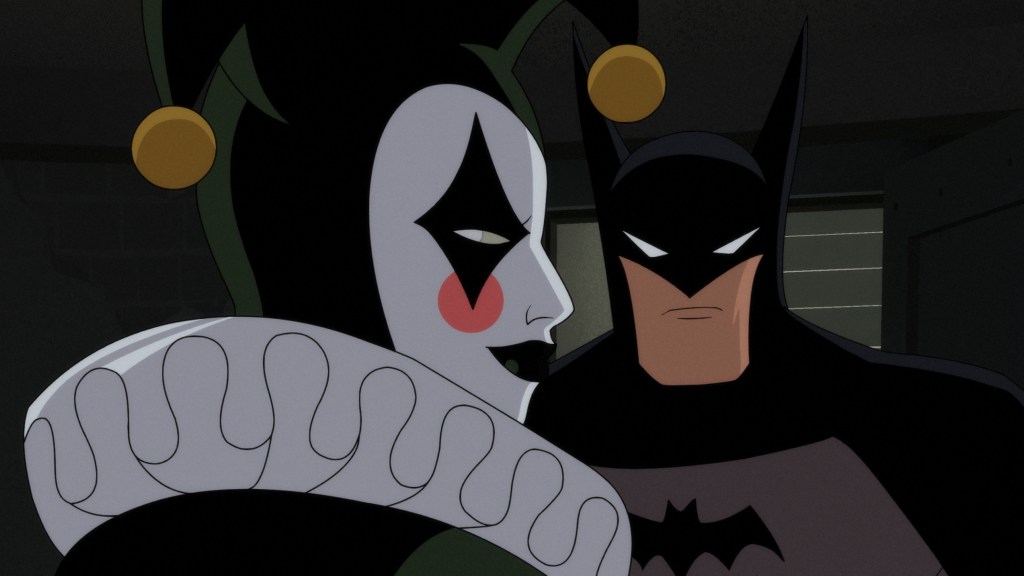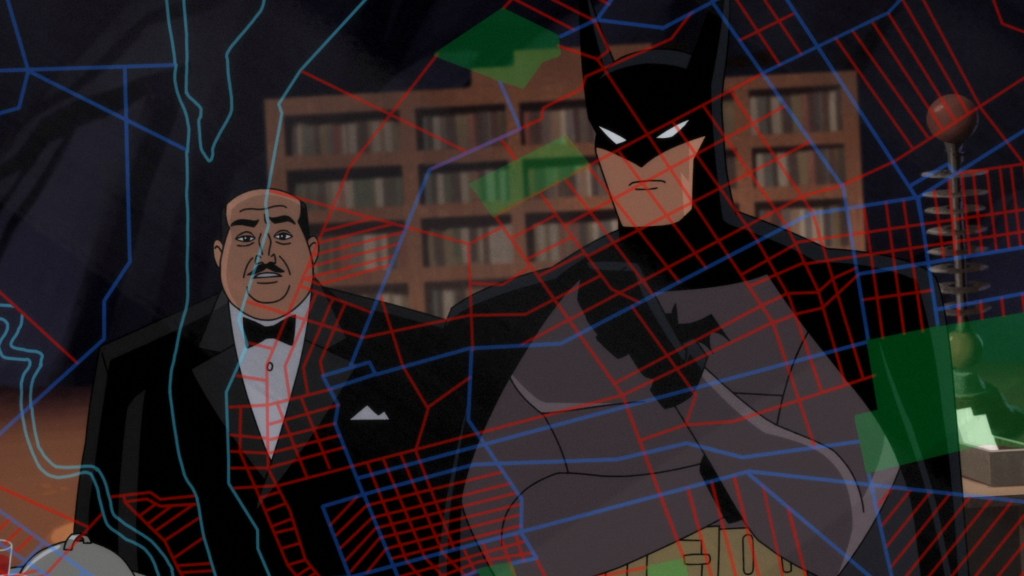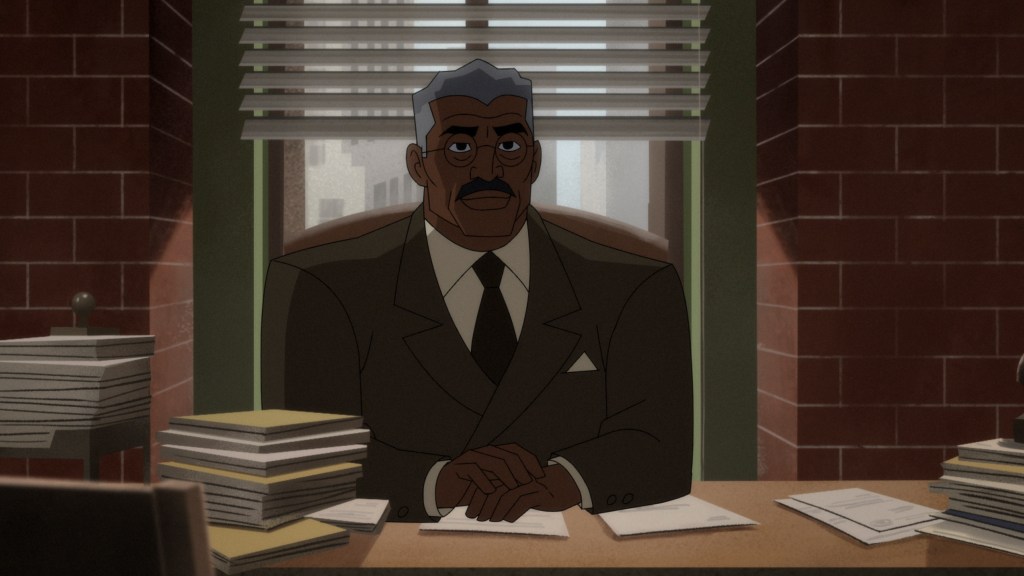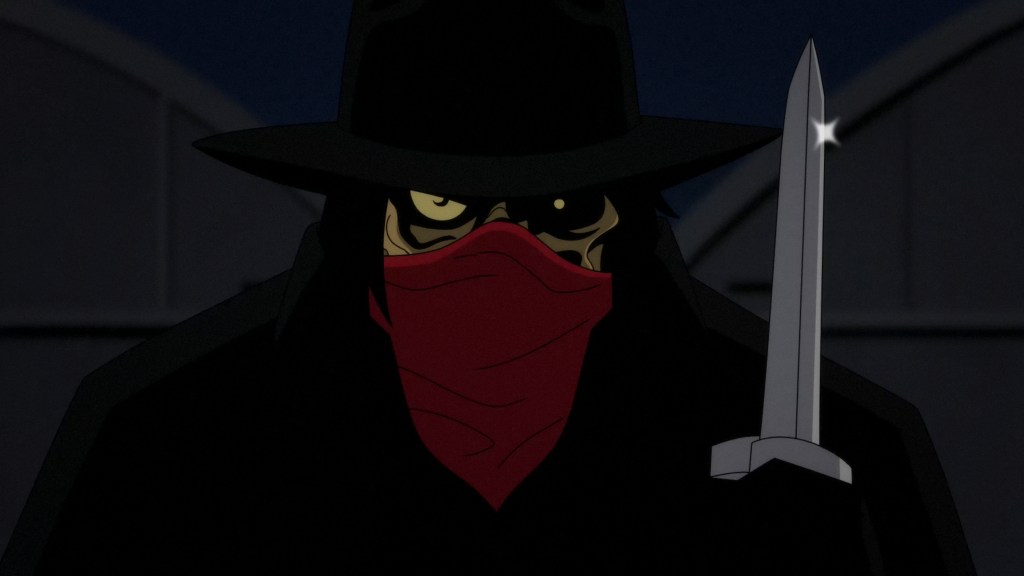Ever since Mark Millar started a hoax that Orson Welles was at one time considering making a Batman movie, a certain segment of fandom has been enamored with the idea of a Batman story set in the ’30s or ’40s. After all, Batman made his comics debut in 1939, yet the only filmed adaptations we have of him in that era are two serials with really cheesy costumes. Those early Bob Kane stories have an era-specific dark tone to them that’s distinctly different from the Frank Miller ’80s version of a dark tone, one that went away after World War II and the arrival on the page of Robin the Boy Wonder.
Batman: Caped Crusader attempts to take this on, but with a modern twist. Set at the beginning of Batman’s career, it takes Bruce Timm‘s retro-futurist style and removes all the “futurist” parts, while making his character designs slightly less triangular. (If McFarlane makes action figures, they’ll have thicker legs to stand on.) The year is not specified, but it’s not our Earth anyway. Gotham looks to be 1930s-ish, minus bigotry — every profession is fully racially integrated, and at least three characters are openly gay.

Strange Magic
But before anyone claims that’s unrealistic, let us also point out that ghosts and energy vampires exist in this world, and frankly, it’s less “realistic” that Harleen Quinzel is a successful psychiatrist to the rich and famous in the ’30s than that she’s Asian or openly queer. Different reality, different history, although this Harley behaves so much more like Hugo Strange, they probably should have made her a gender-flipped version of him instead.
Instead, it’s the Penguin who gets gender-flipped, as a large female cabaret singer and mother to an odious pair of man-boys. Nothing wrong with that, except perhaps the inelegant-sounding name “Oswalda.” Rupert Thorne is the primary crime boss, giving us a welcome break from the overused Sal Maroni and Carmine Falcone. As for the more colorful villains, the show avoids too-obvious choices like the Joker (who’ll be in season 2), with some deep dives like Onomatopoeia and the Gentleman Ghost. Each episode features a villain of the week with a longer arc of Harvey Dent’s mayoral campaign — and any Bat-fan can predict how that’s going to end.

As for Batman, he boasts his original costume, save the purple gloves which are black here. Alfred, as in the earliest comics, is a double-chinned, portly fellow — he didn’t get thin until the Lewis Wilson serial first portrayed him that way. Batman still snarlingly addresses him as “Pennyworth,” only gradually becoming his friend as well as his employer. Kevin Conroy set the standard for the lead role, and Hamish Linklater is up to it but cannot exceed it.
Gang’s All Here
Unlike the early comics, this Bat-universe comes complete with all the usual supporting characters, from Commissioner Gordon and Barbara to officers Bullock, Montoya, and Flass (played by Mark Boone Jr. in The Dark Knight, he’s now Black and drawn to look a bit like Dick Tracy foe Flattop). Bullock suffers most in transition; after Gotham and Donal Logue significantly humanized the character, he’s back to being a fat, corrupt drunk. And the local orphanage is home to Dick, Jason, and Carrie, just waiting to get old enough to be sidekicks.
With Timm, Matt Reeves, JJ Abrams, and Ed Brubaker as executive producers, this could have been a creative mess, but everyone seems to be on the same (black construction paper) page — make Batman: The Animated Series again, only different. Mission accomplished. While certain self-professed anti-wokesters may take issues with some of the diversity changes, they can always go back and watch the original. There’s simply no point in, for instance, retelling the Two-Face origin story in exactly the same way, beat by beat.

Dented Dignity
Indeed, the changes made to that storyline are bold and fascinating: Harvey Dent is no white knight here, but a narcissistic jerk, drawn to look a bit like Billy Zane. When his face gets scarred, it’s the “monster” face that’s regretful and penitent, while the human face remains, and is, punchable. The performance is some of Diedrich Bader’s finest work, voice-over or otherwise; he’s always played a great doofus, and even a campy Batman in the past, but this time, he plays the split-personality for real, and it’s magnificent.
Timm loves old movies, and it shows, particularly in the second, Clayface-centric episode. Dan Donohue plays Basil Karlo explicitly as a riff on Boris Karloff, with a tertiary villain based on real-life makeup maestro Jack Pierce. London After Midnight, The Phantom of the Opera, and some swashbuckling vibes all come into play to create a Svengoolie fan’s dream cartoon. With movie directors Reeves and Abrams aboard, the whole thing feels far more cinematic than any of DC’s recent DTV animated movies — the sheer language of establishing shots, Dutch angles and mood lighting is different than the long takes cartoons tend to use in order to keep the same background cel for as long as possible.

May We Have Some More?
It’s too bad the modern paradigm for premium animated shows is 10 episodes on streaming with an indefinite wait for more, rather than annual 22-episode seasons, but perhaps it’s creatively for the better, as all these producers seem very busy. Their powers combined have paid off — Batman: Caped Crusader may not be in continuity with The Animated Series and Batman Beyond, but it’s the truest extension of them we’ve gotten since, and very much the same tone…albeit with a touch more swearing and murder. This is Prime Video, after all.
Grade: 4.5/5
Batman: Caped Crusader begins streaming on August 1 on Prime Video.







